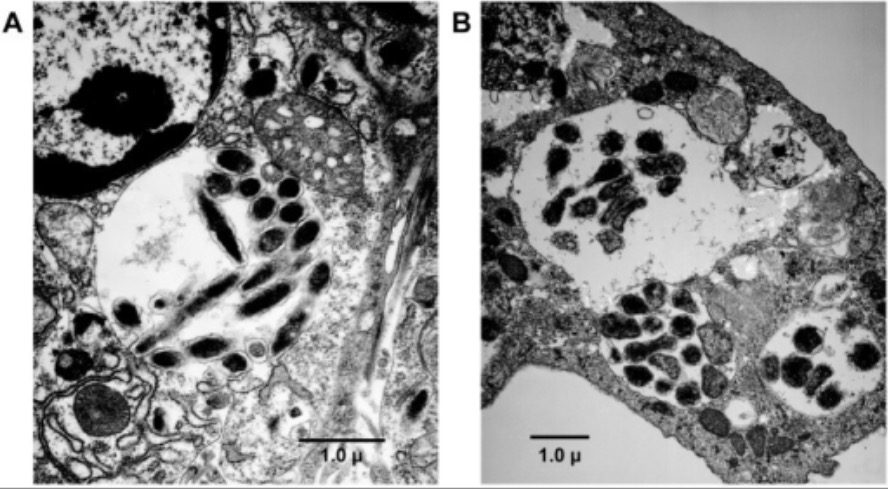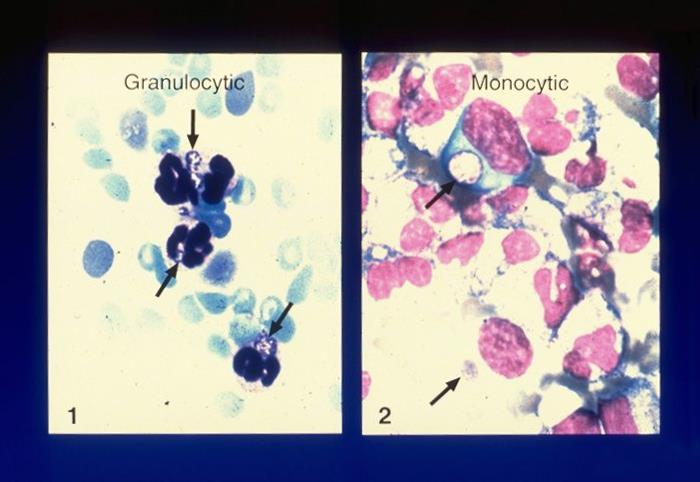Ehrlichiosis and anaplasmosis are tick-borne bacterial infections. The most common causative species include Ehrlichia chaffeensis and Anaplasma phagocytophilum, which infect and multiply within monocytes and granulocytes, respectively. The clinical presentation can vary widely, but often includes fever, malaise, headache, myalgia, and arthralgias. A maculopapular or petechial rash occurs in some patients. Gastrointestinal, neurologic, and respiratory symptoms are also possible. The diagnosis is based on clinical suspicion and confirmed PCR or antibody testing. Management is with doxycycline.
Last updated: Jan 28, 2025

Microscopic images of Giemsa-stained cells infected with anaplasmosis:
Cell nuclei are labeled “N” and the arrows point to Anaplasma morulae.
The most notable species are:
Rare causes of ehrlichiosis Ehrlichiosis Ehrlichiosis is a tick-borne bacterial infection. The most common causative species include Ehrlichia chaffeensis, which infect and multiply within monocytes. The clinical presentation can vary widely, but often includes fever, malaise, headache, myalgia, and arthralgias. Ehrlichiosis and Anaplasmosis in humans:
For ehrlichiosis Ehrlichiosis Ehrlichiosis is a tick-borne bacterial infection. The most common causative species include Ehrlichia chaffeensis, which infect and multiply within monocytes. The clinical presentation can vary widely, but often includes fever, malaise, headache, myalgia, and arthralgias. Ehrlichiosis and Anaplasmosis/ anaplasmosis Anaplasmosis Anaplasmosis is a tick-borne bacterial infection. The most common causative species include Anaplasma phagocytophilum, which infect and multiply within granulocytes. The clinical presentation can vary widely, but often includes fever, malaise, headache, myalgia, and arthralgias. Ehrlichiosis and Anaplasmosis:
For severe disease:

A Lone Star tick, which can transmit E. chaffeensis
Image: “Amblyomma americanum tick” by James Gathany. License: Public Domain
Transmission electron microscopy analysis of E. chaffeensis infected ticks:
E. chaffeensis organisms appear in cytoplasmic vacuoles of a tick’s midgut cell.
A wide range of wild and domestic animals Animals Unicellular or multicellular, heterotrophic organisms, that have sensation and the power of voluntary movement. Under the older five kingdom paradigm, animalia was one of the kingdoms. Under the modern three domain model, animalia represents one of the many groups in the domain eukaryota. Cell Types: Eukaryotic versus Prokaryotic can serve as reservoirs. The most notable are:
Human monocytic ehrlichiosis Human Monocytic Ehrlichiosis Ehrlichiosis and Anaplasmosis:
Human granulocytic anaplasmosis Human Granulocytic Anaplasmosis Ehrlichiosis and Anaplasmosis:
The incubation Incubation The amount time between exposure to an infectious agent and becoming symptomatic. Rabies Virus period is typically 1–2 weeks, and the clinical presentation can vary greatly.
Features of both HME HME Ehrlichiosis and Anaplasmosis and HGA HGA Ehrlichiosis and Anaplasmosis:
Findings more commonly seen in HME HME Ehrlichiosis and Anaplasmosis:
About half of infected individuals require hospitalization Hospitalization The confinement of a patient in a hospital. Delirium, with up to a 2.7% and a 0.3% mortality Mortality All deaths reported in a given population. Measures of Health Status rate associated with HME HME Ehrlichiosis and Anaplasmosis and HGA HGA Ehrlichiosis and Anaplasmosis, respectively. The risk of severe disease and complications is increased in immunocompromised immunocompromised A human or animal whose immunologic mechanism is deficient because of an immunodeficiency disorder or other disease or as the result of the administration of immunosuppressive drugs or radiation. Gastroenteritis individuals, those with extremes of age, and those with delayed treatment.
Differences in diagnostic and management approaches are seen based on practice location. The following information is based on US (ehrlichiosis and anaplasmosis) and European literature and guidelines.
Diagnostic principles:[5,6,9,11,13]
Definitive studies:
Supporting laboratory studies:[11–14]

Peripheral blood smear evaluations for ehrlichiosis and anaplasmosis:
These blood smears show intracellular morulae of A. phagocytophilum (1) and E. chaffeensis (2).
Doxycycline is the antibiotic of choice.
Avoiding tick bites is key to preventing these diseases.
In the United States, HGA HGA Ehrlichiosis and Anaplasmosis and HME HME Ehrlichiosis and Anaplasmosis are nationally reportable conditions and should be reported to local and/or state health departments (depending on the state).
| Organism | Ehrlichia chaffeensis Ehrlichia chaffeensis A species of gram-negative bacteria that is the causative agent of human ehrlichiosis. This organism was first discovered at fort chaffee, arkansas, when blood samples from suspected human ehrlichiosis patients were studied. Ehrlichiosis and Anaplasmosis | Anaplasma phagocytophilum Anaplasma phagocytophilum A species of gram-negative bacteria in the genus anaplasma, family anaplasmataceae, formerly called ehrlichia phagocytophila or ehrlichia equi. This organism is tick-borne (ixodes) and causes disease in horses and sheep. In humans, it causes human granulocytic ehrlichiosis. Ehrlichiosis and Anaplasmosis | Rickettsia rickettsii Rickettsia rickettsii A species of gram-negative, aerobic bacteria that is the etiologic agent of rocky mountain spotted fever. Its cells are slightly smaller and more uniform in size than those of rickettsia prowazekii. Rickettsia | Borrelia burgdorferi Borrelia burgdorferi A specific species of bacteria, part of the borrelia burgdorferi group, whose common name is lyme disease spirochete. Borrelia |
|---|---|---|---|---|
| Disease | HME HME Ehrlichiosis and Anaplasmosis | HGA HGA Ehrlichiosis and Anaplasmosis | Rocky Mountain spotted fever Fever Fever is defined as a measured body temperature of at least 38°C (100.4°F). Fever is caused by circulating endogenous and/or exogenous pyrogens that increase levels of prostaglandin E2 in the hypothalamus. Fever is commonly associated with chills, rigors, sweating, and flushing of the skin. Fever | Lyme disease Lyme disease Lyme disease is a tick-borne infection caused by the gram-negative spirochete Borrelia burgdorferi. Lyme disease is transmitted by the black-legged Ixodes tick (known as a deer tick), which is only found in specific geographic regions. Patient presentation can vary depending on the stage of the disease and may include a characteristic erythema migrans rash. Lyme Disease |
| Micro |
|
|
|
|
| Vector | Lone Star tick Lone Star Tick Rocky Mountain Spotted Fever | Ixodes tick | Dermacentor Dermacentor A widely distributed genus of ticks, in the family ixodidae, including a number that infest humans and other mammals. Several are vectors of diseases such as tularemia; rocky mountain spotted fever; colorado tick fever; and anaplasmosis. Rickettsia tick | Ixodes tick |
| Reservoir Reservoir Animate or inanimate sources which normally harbor disease-causing organisms and thus serve as potential sources of disease outbreaks. Reservoirs are distinguished from vectors (disease vectors) and carriers, which are agents of disease transmission rather than continuing sources of potential disease outbreaks. Humans may serve both as disease reservoirs and carriers. Escherichia coli | White-tailed deer | White-footed mouse | Dermacentor Dermacentor A widely distributed genus of ticks, in the family ixodidae, including a number that infest humans and other mammals. Several are vectors of diseases such as tularemia; rocky mountain spotted fever; colorado tick fever; and anaplasmosis. Rickettsia tick |
|
| Geographical distribution in the United States | Southeast and South Central states | Northeast and upper Midwest states | Southeast and South Central states | Northeast and Midwest states |
| Diagnosis |
|
|
|
|
| Management | Doxycycline |
|
||